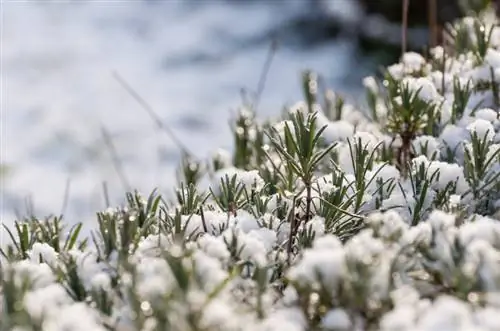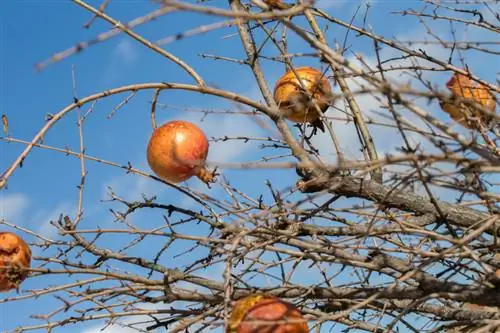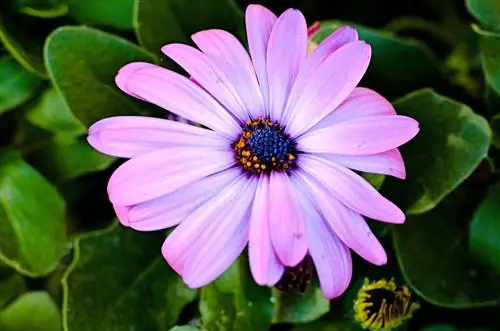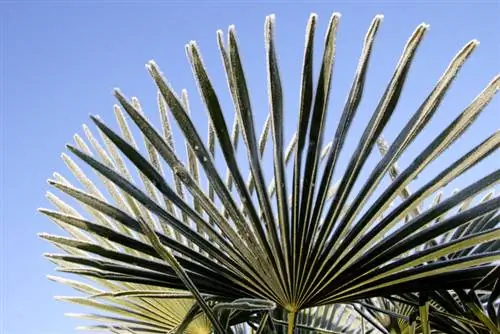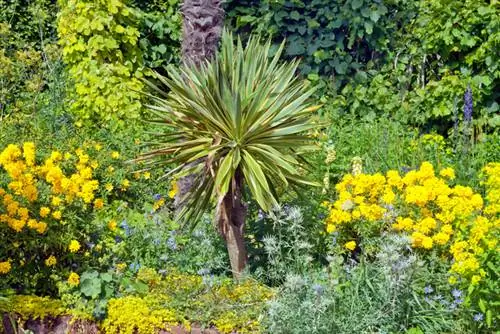- Author admin [email protected].
- Public 2023-12-16 16:46.
- Last modified 2025-01-23 11:21.
When most people hear the term “Yucca,” they think of the popular houseplant with the thick trunk and the typical, palm-like tuft of leaves. In fact, the yucca or palm lily family is very large, comprising around 50 different species. These plants, which are native to very different habitats, are often only suitable for indoor cultivation, but are sometimes also frost hardy. Yuccas grown in pots, on the other hand, should always be kept frost-free over the winter.
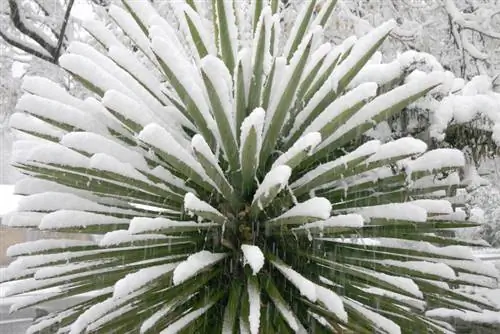
Are yucca palms hardy?
Some yucca species, such as the filamentous palm lily (Yucca filamentosa) and the candle palm lily (Yucca gloriosa), are hardy down to -15°C and -20°C, respectively. In extreme temperatures, it is recommended to protect the root area with mulch and wrap the plant with garden fleece (€6.00 on Amazon) or reed mats.
Hardy Garden Yuccas
The filamentous palm lily (Yucca filamentosa)
Frost-hardy, for example, is the popular filamentous palm lily (Yucca filamentosa), whose flower stalks with numerous bell-shaped flowers can grow up to two meters (and sometimes even more) and look extremely impressive every year when they bloom between June and October. The Yucca species, which originally comes from North America, is frost hardy down to minus 15 °C and only requires light winter protection at even lower temperatures. Very young specimens first have to get used to the temperatures and should therefore initially overwinter in cold house conditions. When planting, make sure that you choose a bright and, above all, protected location - the filamentous palm lily does not like rain or drafts.
The candle palm lily (Yucca gloriosa)
The Yucca gloriosa, also known as the candle palm lily, is even less sensitive to frost than the Yucca filamentosa: This species can even tolerate temperatures of minus 20 °C and only needs a light frost protection made of bark mulch and leaves during longer cold periods. However, as with all palm lilies, moisture is more problematic. Make sure the soil is loose and well-drained and that the plant is protected from excessive moisture during frequent rain.
When is winter protection necessary?
Both types of Yucca do not require winter protection in normal winters. Only if the temperatures drop very low or it is very cold for a long period of time should you mulch the root area and, above all, wrap the filamentous palm lily with garden fleece (€6.00 at Amazon) or reed mats. Above all, make sure that the roots are not damaged. If the above-ground parts of the plant have frozen back, you can cut them off and the plant will sprout again - provided the roots remain he althy.
Overwinter yuccas properly in pots
Potted plants are exposed to frosty temperatures to a much greater extent than planted specimens; after all, the soil layer that protects them from the cold is missing. It is therefore best to overwinter even hardy palm lilies in cold house conditions during the cold season. This means that you place the plants in a cool and bright room with temperatures ideally between five and ten degrees Celsius. Potted plants should be moved to their winter quarters before the first frost. In mild winters or if you do not have a place to overwinter at home, you can also pack the plants with suitable materials. Above all, the pot with the roots should be protected from frost.
Tip
The popular indoor yucca (Yucca elephantipes) is not hardy, but can also be grown outdoors in the warm and dry summer months. However, slowly get the plant used to the new environment.


